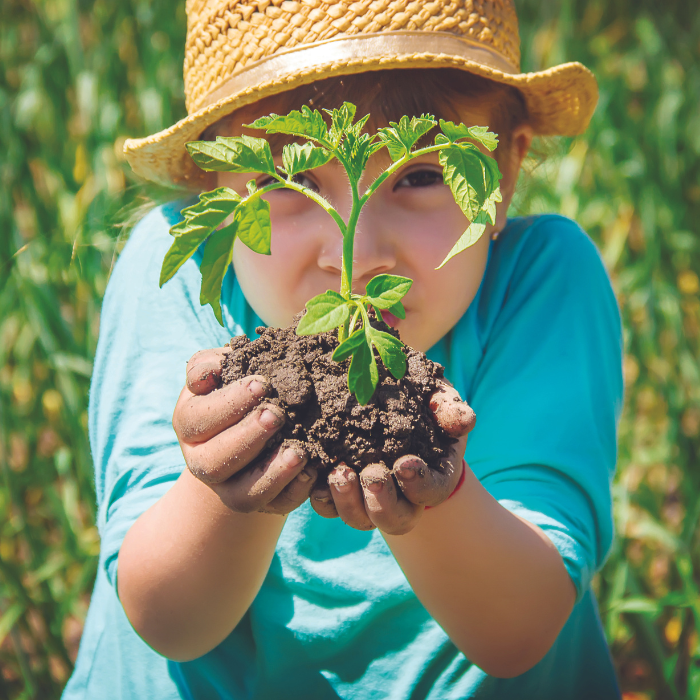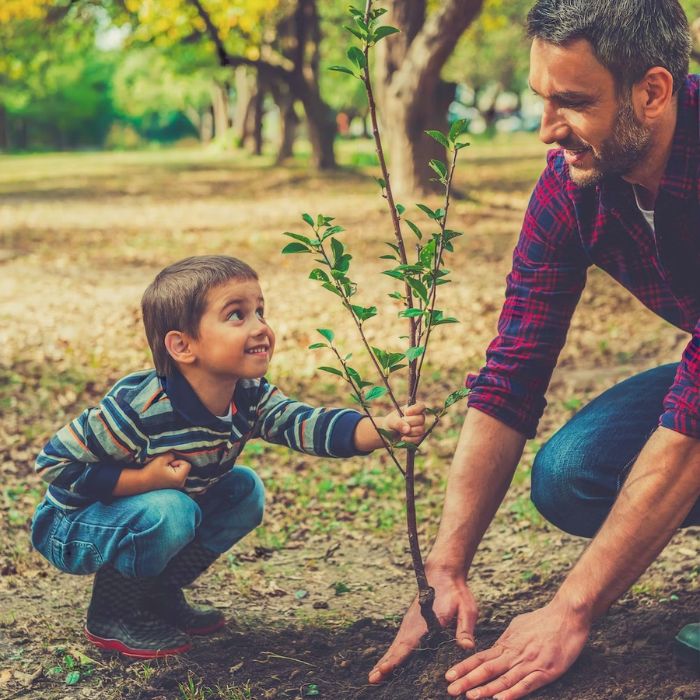
Welcome wildlife into your garden and you create a wonderland for your children too.
There’s a saying that conservation begins at home. Your home garden is the perfect place to put this into practice, but even more importantly, it’s the perfect way to introduce children to conservation.
Children and gardening are made for each other. Most children are naturally curious and there is so much to discover, both above and below ground. They love using tools and most love getting dirty. There is something that children of all ages can do in the garden, with your help.
By creating a garden that welcomes wildlife, you not only benefit conservation, you also help your child learn about the world around them and nurture a sense of responsibility towards its care. And a wildlife-friendly garden has hidden nooks and crannies that will appeal to children as much as it does to other creatures.
Help get them excited about gardening by giving them their own sunny corner ? or even a container if you don’t have much space (tyre stacks work well). Children love watering and digging and, once they’ve been shown, you can leave them to do most of the work themselves; plants are pretty forgiving. Choose plants that grow quickly for faster recognition of your child’s efforts, or create a themed garden – a home for bees, butterflies or even fairies!
gardens can be a place for learning
- All the basic principles of nature are all there ? how food chains work, how plants and trees grow, where creatures live, pollination ? a science lab is at your back door.
- Introduce your child to a variety of plants that are great to smell, fun to touch and good to eat, such as lavender, tarata/lemonwood, rosemary, kawakawa and even stinkwood/hupiro. Through engaging all their senses, they will remember the names and understand the value plants provide.
- Gardening introduces children to some of the living creatures in the soil, under rocks and on plants. It’s all a part of opening the world up to them.
- They will also learn valuable lessons about: patience as they wait for vegetables to grow; responsibility as they care for their garden; cause and effect as they see the impact of the environment on how plants grow; and about where food comes from.
basic principles of backyard biodiversity
First, find out what native plants grow naturally in your area. These will be the plants best adapted to survive your local conditions, and be the preferred food source for local wildlife. Regional council websites are often a good source of information about local plants.
Visit a nearby reserve or a patch of native forest and look at the plant associations ? how the heights, colours and shapes of the different plants work together. Plant a mix of plants, and plant densely.
Try to choose a range of plants that flower or fruit successively, so that your garden provides a continuous source of nectar and pollen resources throughout the year for wildlife.
Let areas of long grass grow. Birds, lizards and insects like “messy” gardens best. This provides safe havens for insects to over-winter, nurseries for egg-laying and wild flowers to attract butterflies, hunting grounds for lizards or shelter when it’s really hot or really cold. Long grasses also make great play spaces for children. Nevertheless, you might want to consider garden paving as well, so that you or your children do not accidentally step on the plants, and also to make a nice walkway for your guests and other family members.
Minimise the use of sprays as they kill both the bad bugs and good bugs ? some insects actually benefit your garden and are food sources for birds and lizards. For example, ladybugs are avid aphid hunters.
Add water to your garden if you can do so safely. A high bird bath safe from cats will get lots of use, and bees will gather water from shallow pools to help cool their hive on hot days.
Rocks provide warm places for insects and lizards to rest and sunbathe. Rocks are also great obstacle courses for rock-hopping children!
A compost bin is an integral part of any environmentally-friendly garden.
lizards love …
- Lizard-friendly gardens are ones that offer plenty of hiding places. Long grass, piles of wood, stones, bricks or non-toxic roofing tiles make great homes. Spiders, slaters and beetles will move in too, and become dinner!
- Lizards like to squeeze into body-sized holes about 5-19mm wide.
- Many lizards are territorial so they need their own space; a rock wall provides plenty of lizard homes.
- Plant thickly to give lizards safe habitats to run to when cats are on the prowl.
- Plant berry or nectar-producing plants, especially native divaricating shrubs like Muehlenbeckia or Coprosma. Ferns, tussock grasses and rengarenga lilies provide thick groundcover and attract insects for lizards to eat.
birds prefer “
- Plant trees and shrubs that provide food for birds: fruits, nectar, leaves and flowers. Kowhai, harakeke/flax, kaka beak, tarata/lemonwood and wineberry/korimako have beautiful flowers that are favourites of bellbird/korimako and tui, while kereru/wood pigeon loves fruits of podocarp trees such as tawa and miro.
- Encourage a variety of moths, beetles and spiders in your garden will attract insect-loving birds such as the cheeky fantail/piwakawaka
- Hang bird feeding stations out of reach of cats ? but in a place where children can watch from a window for hours of entertainment.
- Some exotic plants can provide food for native birds when other food is in short supply (for example, Australian gums and proteas and South African red hot pokers produce copious nectar for our honey-eaters, often in autumn and early winter).
- Avoid planting exotics that take off and start to grow outside of your property making them tricky to contain.
butterflies, bees and other beneficial bugs like “
- A pile of logs will provide home for creatures called decomposers which feed on rotting wood and recycle it into soil. Let prunings rot down naturally for natural mulches for insects.
- Most native insects prefer plants with small, open flowers, such as hebes. Pretty little copper butterflies prefer native pohuehue or mingimingi, while common blue butterflies are fond of clover lawns.
- Most adult butterflies feed on a wide range of nectar-producing plants, including old-fashioned cottage-garden flowers and herbs, such as echinacea, lavender and marigolds.
- Flowers that produce pollen will attract honeybees.
- Minimise spraying and only use insecticides specific to the pest you want to target.
- The most well-known butterfly (monarch) is not native to NZ. Plant a swan plant to host a great life-cycle lesson: from egg to caterpillar, chrysalis to butterfly.
edible gardens
Studies have shown that children who help grow their own food are more likely to eat fruits and vegetables. And there is nothing more satisfying than picking strawberries straight from the garden and eating them while they are warm from the sun. Cherry tomato plants, strawberries and a blueberry bush by the front door are great sources of child-friendly snacks, while digging for potatoes is like a backyard treasure hunt.
Sarah Mankelow has worked in conservation for over 15 years, and is mother of two nature-loving children.








